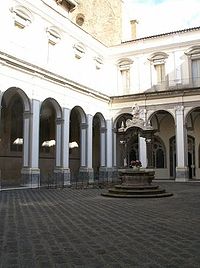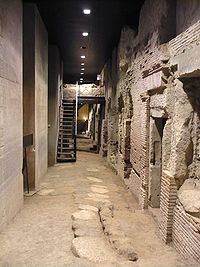
San Lorenzo Maggiore (Naples)
Encyclopedia


Naples
Naples is a city in Southern Italy, situated on the country's west coast by the Gulf of Naples. Lying between two notable volcanic regions, Mount Vesuvius and the Phlegraean Fields, it is the capital of the region of Campania and of the province of Naples...
, Italy
Italy
Italy , officially the Italian Republic languages]] under the European Charter for Regional or Minority Languages. In each of these, Italy's official name is as follows:;;;;;;;;), is a unitary parliamentary republic in South-Central Europe. To the north it borders France, Switzerland, Austria and...
. It is located at the precise geographic center of the historic center of the ancient Greek-Roman city, at the intersection of via San Gregorio Armeno and via dei Tribunali
Via dei Tribunali (Naples)
Via dei Tribunali is a street in the old historic center of Naples, Italy.It was the main decumanus — that is, the main east-west street—of the ancient Greek and then Roman city of Neapolis, paralleled to the south by the lower decumanus and to the north by the upper decumanus...
. The name "San Lorenzo" may also refer to the new museum now opened on the premises, as well as to the Roman archaeological site beneath the church itself.
The church's origins derive from the presence of the Franciscan
Franciscan
Most Franciscans are members of Roman Catholic religious orders founded by Saint Francis of Assisi. Besides Roman Catholic communities, there are also Old Catholic, Anglican, Lutheran, ecumenical and Non-denominational Franciscan communities....
order in Naples during the lifetime of St. Francis of Assisi
Francis of Assisi
Saint Francis of Assisi was an Italian Catholic friar and preacher. He founded the men's Franciscan Order, the women’s Order of St. Clare, and the lay Third Order of Saint Francis. St...
, himself. The site of the present church was to compensate the order for the loss of their earlier church on the grounds where Charles I of Anjou decided to build his new fortress, the Maschio Angioino in the late 13th century.
San Lorenzo actually is a church plus monastery. The new museum takes up the three floors above the courtyard and is given over to the entire history of the area that centers on San Lorenzo, beginning with classical archaeology and progressing to a chart display of historical shipping routes from Naples throughout Magna Grecia and the Roman Empire
Roman Empire
The Roman Empire was the post-Republican period of the ancient Roman civilization, characterised by an autocratic form of government and large territorial holdings in Europe and around the Mediterranean....
. The museum provides a detailed account of the local "city hall" that was demolished in order to put up the church in the 13th century and continues up past the Angevin
Capetian House of Anjou
The Capetian House of Anjou, also known as the House of Anjou-Sicily and House of Anjou-Naples, was a royal house and cadet branch of the direct House of Capet. Founded by Charles I of Sicily, a son of Louis VIII of France, the Capetian king first ruled the Kingdom of Sicily during the 13th century...
period and into more recent history.
Beneath San Lorenzo, about half of an original Roman market has been excavated.The site has been open since 1992, the result of 25 years of painstaking excavation. The market place is the only large-scale Greek-Roman site excavated in the downtown area.
In this church Boccaccio meet his beloved Fiammetta
Fiammetta
Fiammetta, Fiametta — pseudonym of Giovanni Boccaccio's beloved and muse, her real name may have been Maria d’Aquino.-Boccaccio's works with her name:* The Filocolo* Teseida* Il Filostrato* Ninfale d'Ameto...
(1338).
Chapels
Two of the chapels in the GothicGothic architecture
Gothic architecture is a style of architecture that flourished during the high and late medieval period. It evolved from Romanesque architecture and was succeeded by Renaissance architecture....
church are designed in baroque
Baroque
The Baroque is a period and the style that used exaggerated motion and clear, easily interpreted detail to produce drama, tension, exuberance, and grandeur in sculpture, painting, literature, dance, and music...
manner. These are the Cacace Chapel and the Chapel of S. Antonio. Both are designed by Cosimo Fanzago
Cosimo Fanzago
Cosimo Fanzago was an Italian architect and sculptor, generally considered the greatest such artist of the Baroque period in Naples, Italy.-Biography:...
, the first in commission of Giovan Camillo Cacace, lawyer and member of the Accademia degli oziosi, the latter in commission of the Carthusian Order. His use of inlaid, richly colored marble contrasts with the Gothic interior.
Cacace Chapel
The Cacace Chapel is dedicated to Mary of the RosaryRosary
The rosary or "garland of roses" is a traditional Catholic devotion. The term denotes the prayer beads used to count the series of prayers that make up the rosary...
when it was acquired by the De Caro family in 1571. Giovan Camillo Cacace, nephew of Francesco and Giuseppe De Caro, decided to renovate the chapel in the 1640s. He commissioned Cosimo Fanzago for the realization, but other artists were invited as well. The sculpture was executed by Andrea di Bolgi, a sculptor from Carrara who had worked in the Bernini workshop in the 1630s; for him he created the Sant' Helena statue in the crossing of St. Peter's in Rome. In the Cacace Chapel he did the four sculptures, to the left the whole figure of Giuseppe De Caro, kneeling, with below the bust of his brother, Francesco De Caro. To the right is the praying and kneeling figure of Vittoria De Caro, sister of Giuseppe and Francesco, and mother of the commissioner, Giovan Camillo. His bust is shown below Vittoria.
The cupola of the chapel is frescoed by Niccolò De Simone, while earlier this task was appointed to Massimo Stanzione. It depicts the Trinity and glory of the Virgin, though the fresco is severely damaged and hardly visible nowadays. At the sides are the Friendship between Saint Francis and Saint Domenicus and the Sleep of Innocent XIII Who Sees Francis and Dominic rule over the tumbling Lateran. The four pendants the painter depicted John the Baptist, Saint Joseph, Saint Anne and Saint Joachim.
The altarpiece is painted by Massimo Stanzione
Massimo Stanzione
Massimo Stanzione was an Italian Baroque painter, mainly active in Naples.Massimo Stanzione was an Italian Baroque painter. Born in Naples in 1586, Massimo was greatly influenced by Michelangelo Merisi da Caravaggio, but what earned him the nickname of The Neapolitan Guido Reni was his...
and depicts the Our Lady of the Rosary
Our Lady of the Rosary
Our Lady of the Rosary is a title of the Blessed Virgin Mary in relation to the rosary....
, a subject with rising popularity after the Council of Trent
Council of Trent
The Council of Trent was the 16th-century Ecumenical Council of the Roman Catholic Church. It is considered to be one of the Church's most important councils. It convened in Trent between December 13, 1545, and December 4, 1563 in twenty-five sessions for three periods...
of 1563. His style is reminiscent of Caravaggio
Caravaggio
Michelangelo Merisi da Caravaggio was an Italian artist active in Rome, Naples, Malta, and Sicily between 1593 and 1610. His paintings, which combine a realistic observation of the human state, both physical and emotional, with a dramatic use of lighting, had a formative influence on the Baroque...
, though with brighter use of colour and more attention to physiology.

